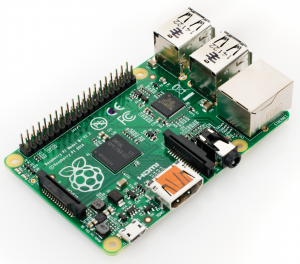 There is something that fascinates me from the new Raspberry Pi, and using it as a media center.
There is something that fascinates me from the new Raspberry Pi, and using it as a media center.
It is the fact that is a really small board.
That is powered by a micro USB 1000 mhA.
That is powered with Linux.
I had other media centers before but they were magnetic hard disk, closed in a proprietary system.
The media center I installed, with RaspBerry Pi+, is osmc, that is Open Source Media Center.
 So I have full access via ssh to the RaspBerry, and as it used so few energy I have it all the day up.
So I have full access via ssh to the RaspBerry, and as it used so few energy I have it all the day up.
Then, as it is a Linux box, and I have full access, and I’ve around 546 MB RAM free, I can run as many background process as I want.
Do I want to be a jump point for my VPN? Let’s go.
Do I want to have some monitoring processes over few websites? Let’s do it!.
I’m really happy about having a so tiny, so few energy consuming, full Linux, being my media center and whatever I want to it to do.
I must say that is wonderful having SSH and a network interface. Ok, it’s 10/100 Mbps, not Gigabit, but it is enough to allow me to copy new files in background to the USB stick via SFTP while reproducing at FullHD Blueray MKV, files right. Also allows to mount network folders via NFS or SMB amd play from them. Copying via SFTP to the USB device is generally very slow -don’t be surprised to upload at 30 KB/s- so I recommend to set a NFS folder in the computer, with read access to the ip of the Raspberry. It’s very cool and plays totally smooth using the 100 Mbit ethernet connection. You can also configure a FTP in the Pi, that will be much faster than the SFTP.
The RaspBerry micro SD card has a performance of ~22 MB, that is enough to boot very quickly and to load programs quite fast. I have other microSD cards with Debian Jessie, and I load PHPStorm (Java based PHP IDE) quite fast.
It boots really fast, in case you stop and start it frequently.
It accepts my wired Mouse and Keyboard, and also wireless bluetooth.
I’m really in love with this small motherboard. :)
This tiny RaspBerry 2, has 4 cores at 900 Mhz.
The CPU announces (cat /proc/cpuinfo):
processor : 3 model name : ARMv7 Processor rev 5 (v7l) BogoMIPS : 38.40 Features : half thumb fastmult vfp edsp neon vfpv3 tls vfpv4 idiva idivt vfpd32 lpae evtstrm CPU implementer : 0x41 CPU architecture: 7 CPU variant : 0x0 CPU part : 0xc07 CPU revision : 5
As you see, it scores only 38.40 bogomips, compared to my tower desktop 6384.59, and my old laptop 2593.45, but it’s still beautiful.
Note: you cannot trust bogomips as a performance measurement, and in addition my computers are Intel based -so CISC architecture- while RasbBerry uses ARM processors that are RISC, that is a completely different architecture. I notice a very fluid speed, only I sense a bit slowliness in the process when I install new packages. When unpacking it feels slow, although it can perfectly be caused by the SSD card IO as well, so I installed iotop and monitorized the I/O while I was installing PHP5 :) . I got small writings up to 1,000 KB/sec, so 1 MB/s, with average of ~30-50KB writing operations, no iowait, while I was seeing with htop that the core unpacking was at 100 % of CPU, the other 3 were free, so my initial conclusion is that the bottleneck was on the CPU. Still happy about my little gadget. :)
The osmc image I installed comes with python 2.7.9 and Linux kernel 3.18.9 as uname -a shows:
Linux osmc 3.18.9-5-osmc #1 SMP PREEMPT Wed Mar 11 18:59:35 UTC 2015 armv7l GNU/Linux
It also comes with wget 1.16 and curl 7.38.0.
In fact the OSMC is based on the Debian Jessie distro.
The OSMC software also have upgrades, and Debian upgrades, that keep the Linux box up to date.
So that brings a lot of possibilities.
After a sudo apt-get update I was able to install htop, mc and apache2.
sudo apt-get install htop sudo apt-get install iotop sudo apt-get install iftop sudo apt-get install mc sudo apt-get install apache2 sudo apt-get install php5 sudo apt-get instlal ncdu
So it’s a lot of fun. :)
Note: Although a 1000mhA is enough (Raspberry Pi 2 needs around 700mhA) if you plan to plug a cheap case 2.5 hard disk without external power -just USB- it will not be enough. In this case I recommend buying a 2000mhA transformer for the Pi, or a external USB hub energy powered (2000mhA otherwise you risk energy from Raspbery + USB hub being to sufficient). If the disk has external power, then you’ll have no probem. Personaly I use USB sticks.
When I had my incubator of Start ups some years ago, one of my Start up project was embedding motherboards within screens, and offering the ability to play videos, images, even flash games and animations, and manage and update everything and update contents for a groups of players from the Internet, or based on time triggers. I was finalist for selling my product to a enormous multinational, it was close, but finally a Korean company with a cheaper (and less powerful solution) won. At that time, it was 2004, motherboards were huge comparing to this tiny piece of hardware and I had to deal with different voltage, power consumption, heat dissipation, safety, etc…. so I’m really in love with this tiny piece hardware that doesn’t need even a ventilator or a big dissipation mechanism.